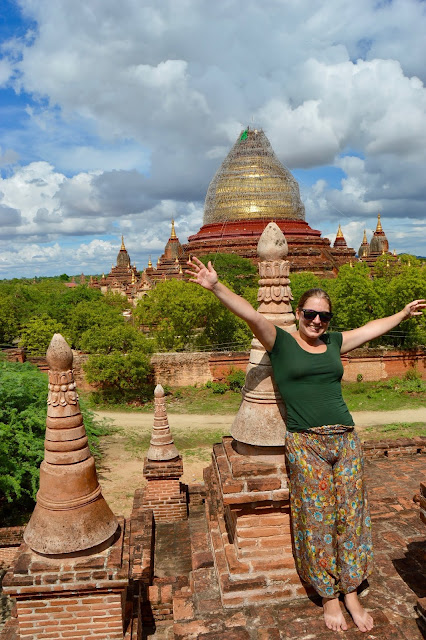Bagan was one of the most beautiful places we’ve seen so far. Known for its more than 2000 temples, the archeological site is undergoing renovations (so far only some of the big temples) since the earthquake in 2016. Some of the buildings, due to the danger of tourists climbing, are closed with padlocks since January 2018. Some locals do possess the keys but don’t trust themselves as often they ask for money in return. Nevertheless, there are still many others open from which you can choose, so please only climb where it’s allowed. An entry fee into Bagan is required and cost 25.000 MMK (15,50 EUR).
I must confess that I still didn’t quite get the names of all the temples, but my recommendation is to rent an e-bike and then use Maps.Me while driving around the three areas of Bagan - Old Town, New Town and Nyaung U - and between the temples. The e-bikes are the best option for the environment and locality, but also for your wallet since you don’t have to pay for fuel. Normal price goes from 4000 to 8000 MMK (2,50 to 5 EUR) depending where you rent. Maps.Me offers important tips (ex. where to climb, or see this and that) and has a good description of most places.
Inside the temples, if they still possess decorated interiors, the most common is to see the gold Buddha statues and the offerings that the locals give.
Avoid to be un-respectful and always take off your shoes when entering a temple or even when you're walking in its premises. Short skirts and shorts, as well t-shirts with cleavage and/or without arms are not well seen and you will probably be asked to cover them. In the big temples, you will be requested to show the entrance ticket you paid at the arrival in Bagan and it will get stamped.
Some temples, like the Ananda Temple, are really well-preserved and show different construction characteristics than the ones in brick wall. This was one of the first great temples to be built in Bagan and one of four that survived. It is completely made of white stone, except the top, and its layout in a cruciform houses four standing Buddhas, each one facing the cardinal direction of East, North, West and South. Also there are four terraces that lead to the top, where it terminates in a small pagoda and an umbrella known as Hti, which is the name of the top ornament found in almost all pagodas in Myanmar. Sadly the temple was damaged in the earthquake of 1975, but it has been fully restored and is well maintained by frequent painting and whitewashing of the walls.
Around the walls of the Shwesandaw Temple near the southern part, there is a long, vaulted-brick structure which houses an 18m long reclining Buddha statue dating the 11th century.
Finally we found the most famous temple, our Goldie or the Dhammayazika Pagoda. It is a Buddhist temple built in 1196 that unfortunately suffered a lot with the recent earthquakes in Myanmar. Parts, like the main entrance, were destroyed and since then the temple is in renovation works. It has a circular design with three terraces and is made, with exception of the stupa, of red brick.
Nearby, the Thitsarwadi Temple or the Tha Mu Hti Temple will allow you to have an overview over the Goldie and the amazing landscape surrounding it. Until the date there was no prohibition about climbing both temples.
The Dhammayangyi Temple is the largest and most popular temple in Bagan and was built in a similar plan to that of Ananda Temple. Burmese chronicles state that while the construction of the temple was in the process, the king was assassinated and thus the temple was not completed. Its interior is bricked up for unknown reasons, thus only the four porches and the outer corridors are accessible.
The Shwezigon Pagoda, one of the last we visited, was in fact one of our least favourites, as everyone working at the entrance stores awaits money from you from the beginning. They even use the technic of saving (kidnap) your stuff, like helmets or shoes, so that you come back and probably buy something. Like in Yangon, the pagoda consists of a circular gold leaf-gilded stupa surrounded by smaller temples and shrines.
At a bend on the right bank of the Ayeyarwady River is the Bupaya Pagoda, a small pagoda with a bulbous shaped dome that was also completely destroyed in the 1975 earthquake. As a result of this earthquake, the bulbous pagoda broke into pieces and fell into the river. It was, however, fully reconstructed using modern materials, with lesser adherence to the original design.
In the old town the ancient town gates still remain partly intact.
On the same day, we took the night bus to Inle Lake, but not before experiencing what a full pick-up taxi is all about.
Next Stop: Inle Lake, Myanmar
For more information:
















































































Comments
Post a Comment